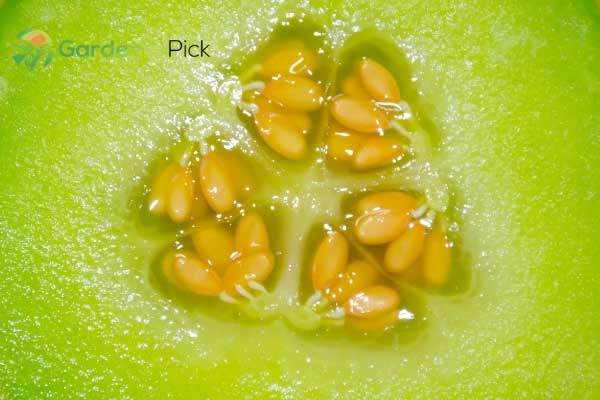Are you planning to grow cantaloupes through seeds in your home garden?
The delicious fruit belongs to the type of Melon. It is also called Muskmelonthat is a warm-weather plant. It has a rough warty rind.
Typically, the skin is covered with a spider-like pattern and green in color. There are some other varieties that have stripped on them.
The flesh is bright orange and sweet inside.
What do you know about cantaloupe seeds?
These are middle-sized seeds of fleshy sweet fruit Cantaloupe. The seeds are found inside the fruit and covered with a layer of thin fiber just like a net. They have various clinical and health advantages. You can use them not only for planting but also for eating purposes.
The fruit has some side effects such as it may cause Diarrhea, Metabolizing difficulty, Gastro problems, and Hamper sugar level.
You might think about cantaloupe seeds to be clean away from fruit and take them later for planting.
But do you ever think about eating seeds?
Yes, it is true…
People in the Middle East and China, have been eating toasted seeds as snacks. In fact, these seeds also provide many health benefits for us.
Cantaloupe seeds were brought from Armenia and later it became the homeland of melons.
Seeds are originated in Persia and cultivated by Egyptians and Greeks.
Are you interested in the germination of Cantaloupes from seeds? Here in this article, we discuss the sowing process as well as the resources for getting seeds.
Do you ready to accept the challenge?
So, be ready and stay connected.
Table of Contents
How to Collect and Store Cantaloupe Seeds
Have you ever got the experience of collecting seeds? It can be creative, provident, and fun to gather seeds of vegetables or fruits from your garden. If you want to save melon seeds for planting in the coming year, it requires attention and planning.
Before saving and collecting seeds, you must be sure that the cantaloupe species are not planted in half a mile from other kinds, which you want to propagate.
You can find seeds in fleshy fruit. You have to wait until the fruits are fully ripe and detached from the vine. After that, you can collect seeds easily.
Cut the fruit lengthwise with a sharp knife, take out the seeds with the spoon, and put them in a jar. Add some hot water and allow the mixture to leave the seeds in two to four days.
The seeds make bubbles when they sit in water. During this process, good seeds sink in the jar, and bad seeds start floating on the top.
Now, let’s learn how to store cantaloupe seeds.
If you don’t know about preserving melon seeds, it is wasting time to harvest them. Drying of seeds is the key part of saving them. If they don’t dry out thoroughly it will cause damage before planting.
After the soaking process, separate the good seeds, put them in a strainer, and clean them. Later on, spread seeds on a towel and leave them to dry for several days.
Now, place them in a clean and dry jar. Label the seed variety and date on the jar, put it in the freezer for 2 days, and then transfer it to the refrigerator.
How Long Does It Take To Grow Cantaloupe From Seeds
Before planting cantaloupes, you must have an idea of the time period it takes to grow from seeds. It is important….
It’s all depends upon the species, care process, and climate where you start germination.
Normally, seeds take 5-10 days to sprout.
Cantaloupe plant takes 85-90 days to grow from seeds to ripe fruit. When the flower has pollinated, it takes 35-45 days to fully ripen.
For a sweeter taste, don’t pick up the fruit from the vine before it ripped. Plant the seeds in a group of two or three at a distance of 2 feet.
High temperatures can shorten the ripping time. So, be sure the temperature should stay above 50-60 degrees.
Where Can You Buy Cantaloupe Seeds?
If we have no melon to get seeds, what could we do?
Mostly, we face the situation of collecting seeds as cantaloupes do not found round the year. It is a warm-season fruit.
Do you forget to save seeds during the summer?
Don’t worry! We have the solution for it.
Cantaloupe seeds are easily available in stores. But before purchasing, you must be sure about the quality. Because bad seeds could not bring the results you want.
So, I recommend the Heirloom Fruit Seeds as the best planting solution.
How to Plant Cantaloupes
After completing the process of seeds collection, take a step towards germination.
Cantaloupes are the warm or hot weather fruit. You can plant them in full sun as they need drained soil.
There are two main methods to plant melon from seeds. You can adopt one of them that you like the best.
Just take your gardening gloves and get ready:
Indoor Method
It is best to start planting seeds indoors if you want to grow them in a cooler climate. Because Cantaloupe seeds need a long warmer season to grow up. The main steps to plant seeds indoors are as follows:
- Take peat pots in your required quantity to plant seeds.
- Sow only one seed per pot at the depth of ¼ inches.
- Water them properly to moisten the soil well.
- The temperature should be 60-95 degrees F for the best germination.
- Set the pots on a propagation mat to keep them warm if the indoor temperature remains below 60 degrees.
- Keep the soil moist by watering it several times per week.
- Keep on watching until you can notice sprouts in 5 to 10 days.
- Don’t move the plant out until several mature leaves appear from the seeds.
- After producing the leaves, plants are now ready to stable outside in the garden.
- Transplant them in the sunny garden bed with fast-draining soil.

Outdoor Method
It is possible to start cantaloupe seeds directly in the garden in a warmer and hot climate. During this season you don’t have any need of transplanting the seeds. Just wait until two weeks after the first frost and get ready to start work. The main steps of planting outdoors are given below:
- Prepare the soil fairly moist and full of organic substances and avoid the poor and dry soil.
- The area you selected for planting should have full exposure to sunlight. Keep away your plant from shady areas.
- Plowing the ground a lot with a rotatory cultivator or milling cutter before sowing seeds.
- Use rich fertilizer or compost for intense mineralization. It must be semi-mature or fresh.
- A couple of weeks before sowing, make superficial hoeing of about 10 inches deep to remove all unwanted weeds.
- Add a new layer of organic compost at this stage.
- Sow the seeds ½ to 1 inch deep and each seed will have a distance of 1 foot.
- Each row has a space of 5 feet to allow the vines to spread easily.
- Make a schedule for watering plants but avoid overloading it. As a lot of water will wash away all seeds.
- The temperature should be 70 degrees F.
- Check the sprouts in a week or two.
- Don’t pick up the fruit before it fully ripens.
- The weight of this giant fruit is about 814g.
- When your fruit reaches the size of a fist, provide them support for hanging. For this purpose, you can use nylon stockings, or netted stretchy bags easily available in store.
Health Benefits of Cantaloupe Seeds
Do you know the health benefits of melon seeds? Yes! They are full of healthy nutrients about which you have no idea. Cantaloupe has also many medicinal properties such as antioxidant, analgesic, vermifuge, diuretic, hepatoprotective, anti-inflammatory, and renal protective activity.
Let’s discuss the health benefits provided by cantaloup seeds:
- Cantaloupe seeds are a big source of protein. It is very difficult to get protein from vegetarian products but melon seeds make it easy. They contain 3.6% protein and 4% fat. So, it is an excellent way to get protein in comparison to soy milk.
- Seeds of melon are best to promote the growth of hair and nails. They also maintain the tissues in the body.
- These seeds are also helpful in the elimination of the intestinal worm from the body. The seeds in the crushed form are more useful. Crushed seeds remove mucus and give relief from congestion.
- As it is a great source of fiber, it serves for weight loss.
- Cantaloupe seeds contain omega-3 fatty acids that could be helpful in the maintenance of hypotension function and prevent the chances of heart problems.
- They provide a big amount of vitamins A, C, and E and help to prevent the devolution in the eyes.
- It helps to maintain the cholesterol level and reduces the chances of cancer. Vitamin C helps to restrain the flu and cold by enhancing the immune system.
- Melon seeds also provide phosphorus, potassium, and magnesium that regulates blood pressure.
- It increases the strength of bones and lowers the risk of diabetes.
- It also treats diseases such as insomnia, depression, and migraines.
Related Article: Are Lemon Seeds Toxic?
Dietary Uses
Some of us think that cantaloupe seeds are useless. We use them only for the seedling.
Do you want to know about the different uses of muskmelon seeds? Don’t worry! Here we go to discuss them. Let’s read:
- You can consume seeds by roasting them. They become delicious after baking.
- They can also be sprinkled on bread, buns, sandwiches, and cakes.
- You can eat them raw or by adding to fruit servings or salads to make it crunchier. It also increases the taste.
- The seeds are also added to smoothies to get more thickness.
- They can also be used for crumbles and apple pie.
- Cantaloupe seeds are helpful to thicken soups, gravies, and stews.
How To Make Roasted Cantaloupe Seeds (15 Min Recipe)
Do you inhabit feeling appetite at any time? You often face the problem of what to eat.
Don’t worry! We have the solution. We are going to share with you the recipe for roasted seeds. Your mouth watered….
Ingredients:
How to Make:
- Take a small bowl, cut the cantaloupe in half, and take out the seeds with a spoon. Squash and pick out the seeds from the fruit flesh netting.
- Save the fruit for another recipe or eat it plain.
- Wash the seeds in a small basket or filter to remove the remaining netting. Now, put them again in the bowl.
- Preheat your oven to 425 F. Mix the salt and olive oil properly. Add them in the seeds and spread the single layer of seeds on a foil-lined cookie sheet.
- Roast them for ten minutes until they get golden brown color. Check them in 3-5 minutes. Now they are ready to eat.
- If your seeds pop, cover them with another aluminum foil paper.
Note: You can also use your stored seeds.
This video will help you to grow cantaloupes outdoors. Don’t skip it.
Conclusion
So, the interesting journey of Cantaloupe Seeds come to its end. To sum up we can say that cantaloupe seeds are easy to grow and maintain, but require a lot of care.
It is a warm-season fruit but you can grow it in cold weather. It requires proper temperature in the indoor climate.
We also come to know about the different uses and health benefits of this giant plant.
You can eat seeds in raw form as well as in salads, cookies, and bread.
Above we also mentioned the storing process of seeds to use them later.
Hopefully, you find this article informative and after reading this, you will be able to grow your
own cantaloupes.
Do you know anything else about cantaloupe seeds?
Don’t be shy! Share it with us via the comment section.






